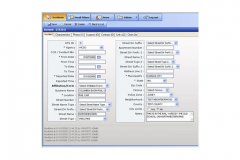Estimative
There are two main systems to manage graffiti vandalism, covering the different categories but especially included in the Environment & Infrastructure category.
In the first place, there are integrated information technology management systems that integrate monitoring and reporting tasks. While in the USA and Australia these are very developed and include also the creation and use of databases, in the four participating countries this technique is less used.
In the UK, over 250 local authorities use Contender Systems Ltd, like the City Council of Sutton (since October 2007). In Sutton, six services are integrated in the system: waste management, street cleansing, highways, abandoned vehicles, winter gritting and graffiti. Contender links calls and e‐mails from residents to front line officers who deal with street scene issues. When customers send an e‐mail they receive an acknowledgement thanking them for their query, which should to be dealt with within seven working days. As we have seen in other cases, the tool is not designed to deal only with graffiti. Waste awareness officers, highway inspectors and street cleansing supervisors use hand held devices called Portable Data Assistants (PDAs) to log issues and receive requests for action out in the field. The system takes as much information from the customer as possible, i.e. name, address and nature of the problem. This information is stored and uses British database address system.
In the second place, Graffiti databases are used in the four participating countries, although they are more complete and advanced in the cases of Germany and UK. Graffiti databases are online platforms that provide intelligence and evidence to the police and the public authorities. They integrate monitoring and reporting systems and they share information so as to fight illegal graffiti.
In the German city of Weimar, they use the database to exchange information between Weimar’s Police and the clerk’s office and authorities. The tool is called Graffiti Cadaster and includes all discovered graffiti, cataloguing and link process relevant data. Also in Germany, there is the ZERP Database39 created and used by Public Transport a Competence Center for security in Westphalia. The Incidents database is in the ZERP implemented database, where it forms an independent database for collecting, managing and analysing photos against illegal graffiti. The ZERP database captures events in the vicinity of public transport that transgress objective and subjective safety. By the incidents database, on a central as well as on a regional level security, officials have the opportunity to analyse the available data and to document developments in their area or region. Based on this information measures are created which allow based on defined criteria to act against and prevent issues. The system supports the user to elaborate regular security reports and analysis. This tool allows to process banning orders (orders to stay away from house or from transport services, so you are not allowed to enter the railway station or use railways for example). The database offers the opportunity to capture, print and search for banning orders.
In the UK, Central government in association with both the private company AGS One and LoveClean Streets leads the National Graffiti Database. The database gets the information from the Love Clean Streets application, which holds an award for the environmental reporting technology.
The Police, Crown Prosecution Service (CPS) and Local Authority Graffiti teams use the platform, but the database also makes available graffiti reports on the website. Besides that, the British Transport Police has an own database on graffiti writers. This tool is both monitoring and management technique because is used to observe patterns of graffiti activities but also as an evidence collector and provider to help direct strategies and effect controls related to graffiti.
In the UK, as well as in the USA and Australia, at least 35 local governments use graffiti mapping database developed by GRIP Systems (Graffiti Reduction and Interception Programs). These are databases of GPS‐encoded digital photographs designed to help authorities detect both ‘hot spots’ for graffiti‐writing activity and active graffiti writers. The software is designed to enable coordinated data entry by different affected groups such as property owners and managers.

